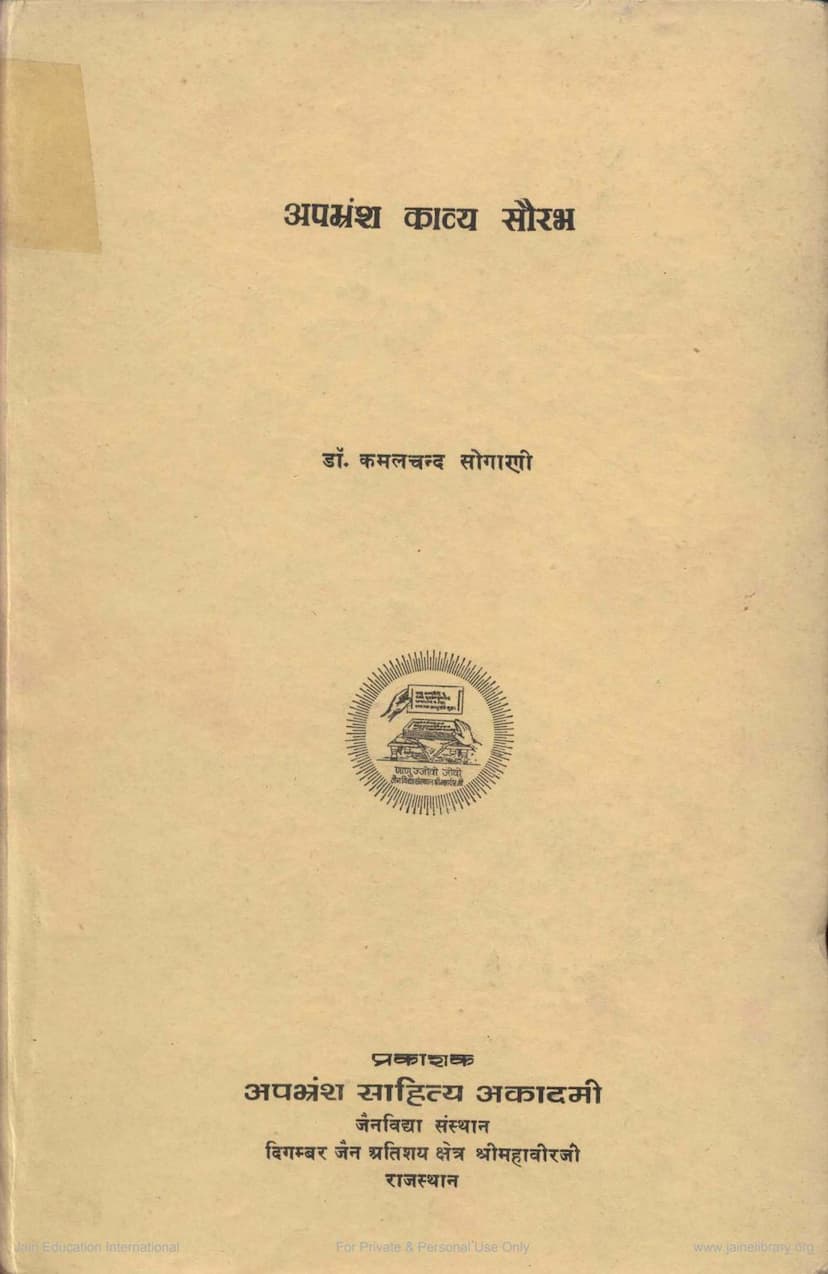Apbhramsa Kavya Saurabh
Added to library: September 1, 2025

Summary
This document is the table of contents and initial pages of "Apabhramsa Kavya Saurabh" (अपभ्रंश काव्य सौरभ), compiled and edited by Dr. Kamalchand Sogani.
Here's a comprehensive summary of the provided text:
Book Title: Apabhramsa Kavya Saurabh (अपभ्रंश काव्य सौरभ) Author/Editor: Dr. Kamalchand Sogani (सेवानिवृत्त प्रोफेसर, दर्शनशास्त्र) Publisher: Apabhramsa Sahitya Academy, Jainvidya Sansthan, Digambar Jain Atishay Kshetra Shri Mahavirji, Rajasthan Publication Year: First Edition, 1992 Catalog Link: https://jainqq.org/explore/001710/1
Overall Purpose: The book is a compilation of selected verses (kavyanshas) from various Apabhramsa literary works. It aims to make Apabhramsa poetry accessible to a wider audience by providing:
- Selected Apabhramsa Verses: Key excerpts from significant Apabhramsa poems.
- Hindi Translation: A translation of these verses into Hindi for better understanding.
- Grammatical Analysis: A detailed grammatical breakdown of the Apabhramsa verses.
- Word Meanings (Shabdarth): Explanations of difficult words.
- Biographies of Poets (Kavi Parichay): Information about the poets.
- Context of Verses (Kavya Prasang): Explanations of the context or background of the selected verses.
Key Themes and Content:
-
Importance of Apabhramsa: The introductory sections emphasize Apabhramsa as the mother language of modern North Indian languages and its crucial role in understanding the history of Hindi and other related languages. It highlights that Apabhramsa literature was vast and popular from the 8th to the 13th century, leading Acharya Hemachandra to dedicate a significant portion of his grammar to it.
-
Revival and Preservation of Apabhramsa Literature: The establishment of the "Apabhramsa Sahitya Academy" under the Jainvidya Sansthan at Shri Mahavirji is mentioned as an effort to promote the study, teaching, and dissemination of Apabhramsa literature. The Academy offers free certificate and diploma courses in Apabhramsa.
-
Structure of the Book: The "Anukramanika" (Table of Contents) reveals a well-structured book that includes:
- Editorial and Preface: Welcoming remarks and introduction to the book's purpose and significance.
- Kavya-Anuvad (Poetic Translation) Section: This forms the core of the book, featuring selected works from prominent Apabhramsa poets and texts:
- Paumachariu (पउमचरिउ): Multiple selections are presented, indicating its importance.
- Mahapurana (महापुराण): Selections from this significant work.
- Jambusamichariu (जंबूसा मिचरिउ): Excerpts from this text.
- Sudarsanachariu (सुदंसणचरिउ): Multiple selections.
- Karakandachariu (करकण्डचरिउ): Verses from this text.
- Dhanakumara Charitra (घण्णकुमारचरिउ): Excerpts from this work.
- Dohas of Hemachandra (हेमचन्द्र के दोहे): Selected dohas by the renowned scholar-poet.
- Paramatmashakti Prakasha (परमात्मप्रकाश): Selections from this spiritual text.
- Pahuda Doha (पाहुदोहा): Verses from this work.
- Savadharm Doha (सावधम्म दोहा): Excerpts related to lay followers' Dharma.
- Vyakaranik Vishleshan evam Shabdarth (व्याकरणिक विश्लेषण एवं शब्दार्थ): A section dedicated to detailed grammatical analysis and word meanings for the selected texts.
- Appendices:
- Parishisht-1 (परिशिष्ट-1): Kavi Parichay (Biographies of Poets) covering poets like Swayambhu, Pushpadanta, Veer, Nayanandi Muni, Kanakamara, Joindu, Ramsingh, Hemachandra Suri, and Devsen.
- Parishisht-2 (परिशिष्ट-2): Kavya Prasang (Context of Verses).
- Errata (Shuddhi Patra): A list of corrections.
- Bibliography (Sahayak Pustakein evam Kosh): A list of reference books and dictionaries.
-
Specific Texts Included (as per the Table of Contents):
- Paumachariu (पउमचरिउ): The most extensively represented text, suggesting its central role. The excerpts likely focus on key events like Abhishek, Dasharatha's reflections, Rama's exile, and the role of characters like Kaikeyi and Kanchuki.
- Mahapurana (महापुराण): Likely includes narrative segments, possibly related to the Bharata-Bahubali conflict.
- Jambusamichariu (जंबूसा मिचरिउ): Focuses on the story of Jambuswami, a significant Jain figure.
- Sudarsanachariu (सुदंसणचरिउ): Highlights the virtue of character and moral teachings.
- Karakandachariu (करकण्डचरिउ): Features the life story of Karakandu, a Jain saint.
- Dhanakumara Charitra (घण्णकुमारचरिउ): Details the life of Dhanakumara, emphasizing karma and destiny.
- Hemachandra's Dohas (हेमचन्द्र के दोहे): Ethical and philosophical verses.
- Paramatmashakti Prakasha (परमात्मप्रकाश): Spiritual and philosophical reflections on the soul and the supreme being.
- Pahuda Doha (पाहुडदोहा): Mystical and introspective verses.
- Savadharm Doha (सावधम्म दोहा): Teachings for lay followers.
-
Grammatical Analysis Focus: The provided sample pages (pages 11-15, 16-17, 18-19, 20-21, 22-23, 24-25, 26-27, 28-29, 30-31, 32-33, 34-35, 36-37, 38-39, 40-41, 42-43, 44-45, 46-47, 48-49, 50-51, 52-53, 54-55, 56-57, 58-59, 60-61, 62-63, 64-65) demonstrate the detailed grammatical analysis. This includes identifying verb forms (active/passive voice, tenses, moods), noun cases (vibhakti), gender, number, pronouns, adjectives, adverbs, and compound word formations (samasa). The analysis appears to be thorough, citing grammatical rules and conventions (e.g., from Hemachandra's Prakrit grammar).
-
Biographies of Poets: The appendices provide concise but informative biographies of major Apabhramsa poets, including their lineage, approximate time period, key works, and the significance of their contributions to Apabhramsa literature and Jain literature.
In essence, "Apabhramsa Kavya Saurabh" is a scholarly and educational resource designed to preserve, promote, and make accessible the rich poetic heritage of Apabhramsa literature, particularly within the Jain tradition. It serves as a valuable tool for students, researchers, and anyone interested in the evolution of Indian languages and literature.